Melanoma
Background
Melanoma is a type of cancer that affects the melanocyte cells of the skin, which produce pigment [1]. Over the past several decades the number of new cases of melanoma in Canada has increased [2]. In 2022, it is estimated that 9,000 Canadians will be diagnosed with the disease [1]. While non-melanoma skin cancer is much more common, melanoma accounts for the most deaths from skin cancer [3].
Exposure to solar radiation is the most important risk factor for melanoma [1]. Non-modifiable (unchangeable) risk factors for melanoma include having many or atypical moles; light-coloured skin, eyes, and/or hair; a personal and/or family history of skin cancer; and rare genetic mutations [4].
Known occupational risk factors
-
- Solar radiation [5]
- Polychlorinated biphenyls (PCBs) [5]
Possible occupational risk factors
-
- Occupational exposure as a firefighter [5]
- Occupational exposures in petroleum refining [5]
Key Findings
In the ODSS, workers in construction trades, agriculture, transport equipment operating, petroleum, protective services, and healthcare were found to have higher risks of melanoma when compared to all workers in the ODSS.
Construction Trades
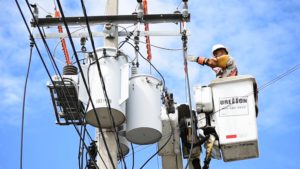 There are several risk factors that may account for the increased risk of melanoma in workers in the construction trades. One possible factor is that construction occupations have one of the highest levels of sun exposure due to the high amount of outdoor work [6].
There are several risk factors that may account for the increased risk of melanoma in workers in the construction trades. One possible factor is that construction occupations have one of the highest levels of sun exposure due to the high amount of outdoor work [6].
Polychlorinated biphenyls (PCBs) are known skin carcinogens that were historically used in a variety of construction materials including electrical equipment, cable insulation, and adhesives [7-8]. In Canada, the 1977 ban on PCBs allowed equipment containing PCBs to be used until the end of its service life, so construction workers may have continued to be exposed when working with older equipment [7].
-
- Construction trades occupations
- Electrical power lighting and wire communications equipment erecting, installing, and repairing: 1.28 times the risk
- Electrical power linemen and related: 2.05 times the risk
- Wire communications and related equipment, installing and repairing: 1.57 times the risk
- Construction electricians and repairmen: 1.14 times the risk
- Electrical power lighting and wire communications equipment erecting, installing, and repairing: 1.28 times the risk
- Construction trades occupations
Agriculture
 Farm workers often work outdoors with prolonged exposure to solar radiation, which may contribute to their increased risk of melanoma [9]. There is also limited evidence for pesticide exposure as a potential risk factor for melanoma [10-11].
Farm workers often work outdoors with prolonged exposure to solar radiation, which may contribute to their increased risk of melanoma [9]. There is also limited evidence for pesticide exposure as a potential risk factor for melanoma [10-11].
-
- Agriculture
- Farm management occupations: 7.07 times the risk
- Miscellaneous specialty farms industry: 1.24 times the risk
- Other farming, horticultural, and animal husbandry occupations: 1.07 times the risk
- Nursery and related workers: 1.28 times the risk
- Agriculture
Transport Equipment Operating
 Workers in transport equipment operating occupations showed higher risks of melanoma in the ODSS. Exposure to ultraviolet (UV) radiation during flights may put aircraft operators at higher risks of developing melanoma [12-14]. Airplane windshields block most, but not all UV transmission [14]. Other transport operating occupations, such as bus, taxi, and truck drivers, may be exposed to UV radiation through vehicle windows.
Workers in transport equipment operating occupations showed higher risks of melanoma in the ODSS. Exposure to ultraviolet (UV) radiation during flights may put aircraft operators at higher risks of developing melanoma [12-14]. Airplane windshields block most, but not all UV transmission [14]. Other transport operating occupations, such as bus, taxi, and truck drivers, may be exposed to UV radiation through vehicle windows.
-
- Transport equipment operating occupations: 1.24 times the risk
- Air transport operating: 1.24 times the risk
- Railway transport operating: 1.63 times the risk
- Locomotive engineers and firemen: 1.81 times the risk
- Conductors and brakemen, railway: 1.75 times the risk
- Motor transport operating: 1.23 times the risk
- Taxi drivers and chauffeurs: 1.77 times the risk
- Bus drivers: 1.42 times the risk
- Truck drivers: 1.22 times the risk
- Other transport and related equipment operating: 1.24 times the risk
- Transport equipment operating occupations: 1.24 times the risk
Petroleum Industries
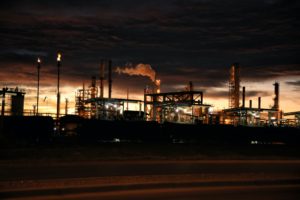 Workers in petroleum industries may be exposed to solar radiation through outdoor work. They may be exposed to chemicals such as polycyclic aromatic hydrocarbons (PAHs) and benzene, but the association with melanoma is unclear [16-18]. PAHs and benzene are found in crude petroleum and petroleum by-products and workers may be exposed through inhalation or skin contact during production, drilling, and maintenance operations [10,18].
Workers in petroleum industries may be exposed to solar radiation through outdoor work. They may be exposed to chemicals such as polycyclic aromatic hydrocarbons (PAHs) and benzene, but the association with melanoma is unclear [16-18]. PAHs and benzene are found in crude petroleum and petroleum by-products and workers may be exposed through inhalation or skin contact during production, drilling, and maintenance operations [10,18].
-
- Crude petroleum and natural gas industry: 1.77 times the risk
- Wholesalers of petroleum products: 1.64 times the risk
Protective Services
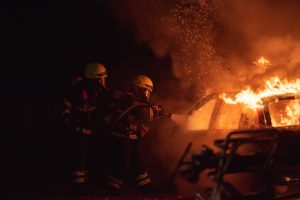 Various protective service occupations were found have higher risks of melanoma in the ODSS. Protective service workers may be exposed to solar radiation during outdoor calls and training [19]. In addition, firefighters may be exposed if PCB-containing materials or equipment are damaged during a fire [15].
Various protective service occupations were found have higher risks of melanoma in the ODSS. Protective service workers may be exposed to solar radiation during outdoor calls and training [19]. In addition, firefighters may be exposed if PCB-containing materials or equipment are damaged during a fire [15].
-
- Protective service occupations: 1.91 times the risk
- Firefighting: 2.37 times the risk
- Policemen and detectives, government: 2.27 times the risk
- Guards and watchmen: 1.24 times the risk
- Protective service occupations: 1.91 times the risk
Healthcare Workers
 It is unclear why healthcare workers have a higher risk of melanoma, although there is some evidence suggesting an association with occupational exposure to ionizing radiation [20-21]. Healthcare workers may be exposed to ionizing radiation through diagnostic and therapeutic procedures, such as medical x-rays. However, non-occupational sun exposure cannot be ruled out.
It is unclear why healthcare workers have a higher risk of melanoma, although there is some evidence suggesting an association with occupational exposure to ionizing radiation [20-21]. Healthcare workers may be exposed to ionizing radiation through diagnostic and therapeutic procedures, such as medical x-rays. However, non-occupational sun exposure cannot be ruled out.
-
- Hospital industry: 1.21 times the risk
- Offices of physicians and surgeons industry: 1.70 times the risk
- Diagnostic and therapeutic services industry, not elsewhere classified: 1.50 times the risk
- Nursing therapy and related assisting operations occupations: 1.29 times the risk
- Supervisors: nursing: 1.82 times the risk
- Nurses, registered, graduate, and nurses-in-training: 1.43 times the risk
- Nursing, therapy and related assisting, not elsewhere classified: 1.53 times the risk
Other Groups
 Several other occupation groups showed higher risk of melanoma, such as teaching and recreational occupations. Workers in these groups may be exposed to long periods of sun exposure from outdoor activities, such as school breaks, field trips, and outdoor sports. Sun exposure outside of work may also play a role in the higher risks observed in these groups.
Several other occupation groups showed higher risk of melanoma, such as teaching and recreational occupations. Workers in these groups may be exposed to long periods of sun exposure from outdoor activities, such as school breaks, field trips, and outdoor sports. Sun exposure outside of work may also play a role in the higher risks observed in these groups.
-
- Teaching and related occupations: 1.83 times the risk
- University teaching and related: 2.10 times the risk
- University teachers: 2.14 times the risk
- University teaching and related: 2.09 times the risk
- Elementary and second school teaching and related: 1.86 times the risk
- Elementary and kindergarten teachers: 2.04 times the risk
- Secondary school teachers: 1.65 times the risk
- Other teaching and related: 1.56 times the risk
- University teaching and related: 2.10 times the risk
- Sport and recreation occupations: 1.74 times the risk
- Coaches, trainers, instructors and managers, sport and recreation: 1.94 times the risk
- Attendants, sport and recreation: 1.67 times the risk
- Teaching and related occupations: 1.83 times the risk
Relative Risk by Industry and Occupation
Figure 1. Risk of melanoma diagnosis among workers employed in each industry group relative to all others, Occupational Disease Surveillance System (ODSS), 2006-2020
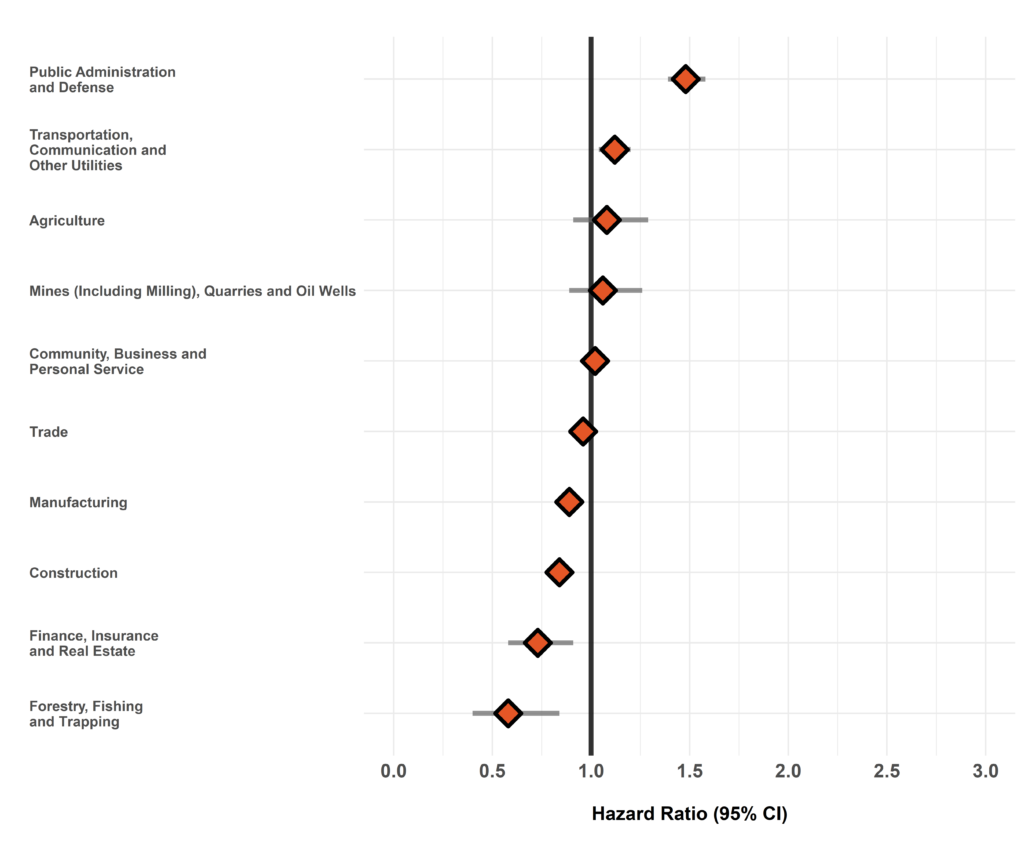
The hazard ratio is an estimate of the average time to diagnosis among workers in each industry/occupation group divided by that in all others during the study period. Hazard ratios above 1.00 indicate a greater risk of disease in a given group compared to all others. Estimates are adjusted for birth year and sex. The width of the 95% Confidence Interval (CI) is based on the number of cases in each group (more cases narrows the interval).
Figure 2. Risk of melanoma diagnosis among workers employed in each occupation group relative to all others, Occupational Disease Surveillance System (ODSS), 2006-2020
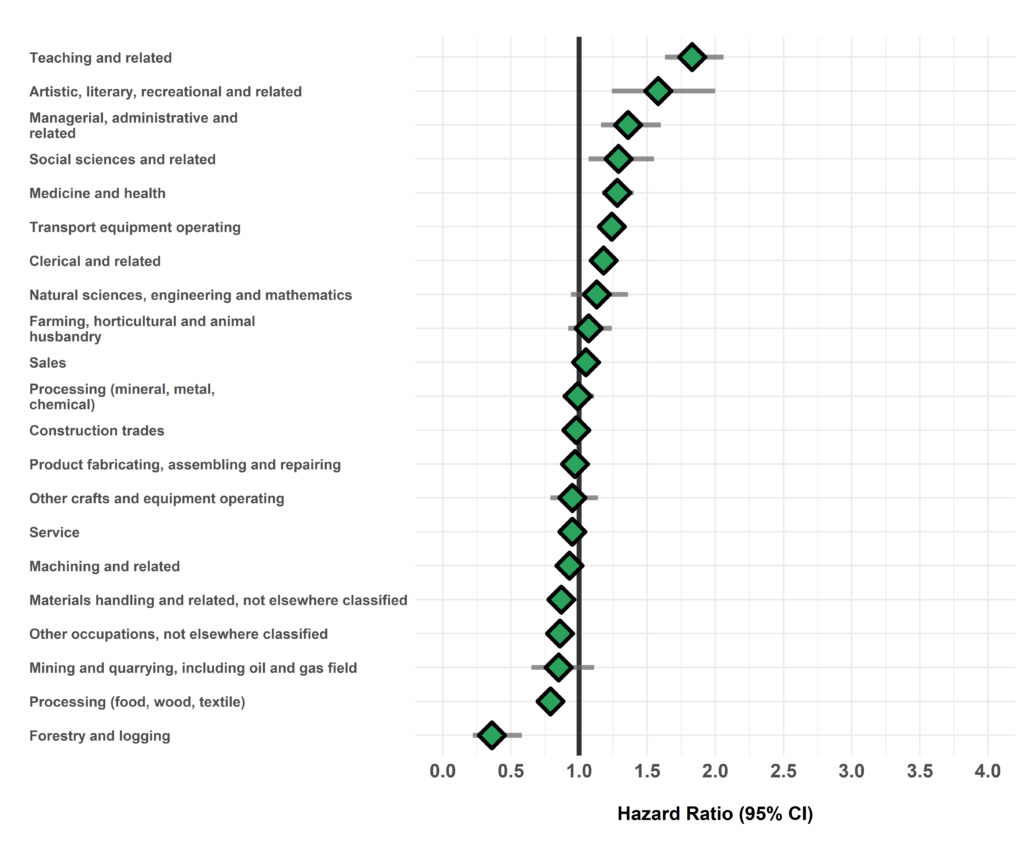
The hazard ratio is an estimate of the average time to diagnosis among workers in each industry/occupation group divided by that in all others during the study period. Hazard ratios above 1.00 indicate a greater risk of disease in a given group compared to all others. Estimates are adjusted for birth year and sex. The width of the 95% Confidence Interval (CI) is based on the number of cases in each group (more cases narrows the interval).
Table of Results
Table 1. Surveillance of melanoma: Number of cases, workers employed, and hazard ratios in each industry (SIC)
| SIC Code * | Industry Group | Number of cases | Number of workers employed | Hazard Ratio (95% CI) † |
| 1 | Agriculture | 128 | 37,891 | 1.08 (0.91-1.29) |
| 2/3 | Forestry, Fishing and Trapping |
28 | 10,754 | 0.58 (0.40-0.84) |
| 4 | Mines, Quarries and Oil Wells |
128 | 24,907 | 1.06 (0.89-1.26) |
| 5 | Manufacturing | 2,777 | 717,441 | 0.89 (0.85-0.93) |
| 6 | Construction | 721 | 227,677 | 0.84 (0.78-0.91) |
| 7 | Transportation, Communication and Other Utilities |
894 | 214,864 | 1.12 (1.04-1.20) |
| 8 | Trade | 1,448 | 468,881 | 0.96 (0.91-1.01) |
| 9 | Finance, Insurance and Real Estate |
73 | 26,035 | 0.73 (0.58-0.91) |
| 10 | Community, Business and Personal Service |
2,071 | 668,779 | 1.02 (0.97-1.07) |
| 11 | Public Administration and Defense |
1,112 | 202,942 | 1.48 (1.39-1.58) |
| * SIC: Standard Industrial Classification (1970) | ||||
| † Hazard rate in each group relative to all others | ||||
Table 2. Surveillance of melanoma: Number of cases, workers employed, and hazard ratios in each occupation (CCDO) group
| CCDO Code * | Occupation Group | Number of cases | Number of workers employed | Hazard Ratio (95% CI) † |
| 11 | Managerial, administrative and related |
153 | 37,871 | 1.36 (1.16-1.60) |
| 21 | Natural sciences, engineering and mathematics |
115 | 29,070 | 1.13 (0.94-1.36) |
| 23 | Social sciences and related fields |
114 | 35,902 | 1.29 (1.07-1.55) |
| 25 | Religion | <5 | 161 | — |
| 27 | Teaching and related | 311 | 61,355 | 1.83 (1.63-2.06) |
| 31 | Medicine and health | 574 | 156,335 | 1.28 (1.17-1.40) |
| 33 | Artistic, literary, recreational and related |
67 | 18,236 | 1.58 (1.24-2.00) |
| 41 | Clerical and related | 835 | 212,717 | 1.18 (1.09-1.26) |
| 51 | Sales | 471 | 164,919 | 1.05 (0.95-1.15) |
| 61 | Service | 1280 | 204,019 | 0.95 (0.90-1.01) |
| 71 | Farming, horticultural and animal husbandry |
178 | 55,593 | 1.07 (0.92-1.24) |
| 73 | Fishing, hunting, trapping and related |
0 | 598 | — |
| 75 | Forestry and logging | 17 | 10,981 | 0.36 (0.22-0.58) |
| 77 | Mining and quarrying, including oil and gas field |
55 | 13,551 | 0.85 (0.65-1.11) |
| 81 | Processing (mineral, metal, chemical) |
314 | 82,596 | 0.99 (0.88-1.11) |
| 82 | Processing (food, wood, textile) |
301 | 104,811 | 0.79 (0.70-0.88) |
| 83 | Machining and related | 772 | 195,975 | 0.93 (0.87-1.00) |
| 85 | Product fabricating, assembling and repairing |
1,383 | 345,106 | 0.97 (0.91-1.03) |
| 87 | Construction trades | 901 | 233,835 | 0.98 (0.91-1.05) |
| 91 | Transport equipment operating |
860 | 183,453 | 1.24 (1.15-1.33) |
| 93 | Materials handling and related, not elsewhere classified |
523 | 162,371 | 0.87 (0.80-0.95) |
| 95 | Other crafts and equipment operating |
119 | 29,367 | 0.95 (0.79-1.14) |
| 99 | Other occupations not elsewhere classified | 714 | 228,095 | 0.86 (0.80-0.93) |
| * CCDO: Canadian Classification Dictionary of Occupations (1971) | ||||
| † Hazard rate in each group relative to all others | ||||
Please note that ODSS results shown here may differ from those previously published or presented. This may occur due to changes in case definitions, methodological approaches, and the ongoing nature of the surveillance cohort.
References
- Canadian Cancer Society. Melanoma [Internet].[cited 2022 30 Sep].
- Conte S, Ghazawi FM, Le M, Nedjar H, Alakel A, Lagacé F, et al. Population-Based Study Detailing Cutaneous Melanoma Incidence and Mortality Trends in Canada. Front Med 2022;9:830254.
- World Health Organization (WHO). Radiation: Ultraviolet (UV) Radiation and Skin Cancer [Internet].[cited 2022 30 Sep].
- Canadian Cancer Society. Skin melanoma risks [Internet].[cited 2022 30 Sep].
- International Agency for Research on Cancer (IARC). List of Classifications by cancer sites with sufficient or limited evidence in humans, IARC Monographs Volumes 1-127. 2022.
- Peters CE, Nicol A-M, Demers PA. Prevalence of exposure to solar ultraviolet radiation (UVR) on the job in Canada. Can J Public Health 2012;103:223–6.
- Health Canada. PCBs [Internet]. [cited 2022 30 Sep].
- United States Environmental Protection Agency. Polychlorinated Biphenyls (PCBs) [Internet].[cited 2022 Jun 6].
- CAREX Canada. Solar UV Radiation Occupational Exposures [Internet].[cited 2022 30 Sep].
- Fortes C, de Vries E. Nonsolar occupational risk factors for cutaneous melanoma. Int J Dermatol 2008;47:319–28.
- Stanganelli I, De Felici MB, Mandel VD, Caini S, Raimondi S, Corso F, et al. The association between pesticide use and cutaneous melanoma: a systematic review and meta-analysis. J Eur Acad Dermatol Venereol 2020;34(4):691-708.
- Gudmundsdottir EM, Hrafnkelsson J, Rafnsson V. Incidence of cancer among licenced commercial pilots flying North Atlantic routes. Environ Health 2017;16:86.
- Hammer GP, Auvinen A, Stavola BLD, Grajewski B, Gundestrup M, Haldorsen T, et al. Mortality from cancer and other causes in commercial airline crews: A joint analysis of cohorts from 10 countries. Occup Environ Med 2014;71:313–22.
- Sanlorenzo M, Wehner MR, Linos E, Kornak J, Kainz W, Posch C, et al. The risk of melanoma in airline pilots and cabin crew: A meta-analysis. JAMA Dermatol 2015;151:51.
- International Agency for Research on Cancer (IARC). IARC Monographs on the Evaluation of Carcinogenic Risk to Humans. Volume 107. Polychlorinated Biphenyls and Polybrominated Biphenyls. 2016.
- Vujic I, Gandini S, Stanganelli I, Fierro MT, Rappersberger K, Sibilia M, et al. A meta-analysis of melanoma risk in industrial workers. Melanoma Res 2020;30:286–96.
- Onyije FM, Hosseini B, Togawa K, Schüz J, Olsson A. Cancer incidence and mortality among petroleum industry workers and residents living in oil producing communities: A systematic review and meta-analysis. Int J Environ Res Public Health 2021;18:4343.
- Stenehjem JS, Robsahm TE, Bråtveit M, Samuelsen SO, Kirkeleit J, Grimsrud TK. Aromatic hydrocarbons and risk of skin cancer by anatomical site in 25 000 male offshore petroleum workers. Am J Ind Med 2017;60:679–88.
- Sritharan J, Kirkham TL, MacLeod J, Marjerrison N, Lau A, Dakouo M, et al. Cancer risk among firefighters and police in the Ontario workforce. Occup Environ Med. 2022;79:533–39.
- Freedman DM, Sigurdson A, Rao RS, Hauptmann M, Alexander B, Mohan A, et al. Risk of melanoma among radiologic technologists in the United States. Int J Cancer 2003;103:556–62.
- Wakeford J. Radiation in the workplace—a review of studies of the risks of occupational exposure to ionising radiation. J Radiol Prot. 2009;29:61-79.
